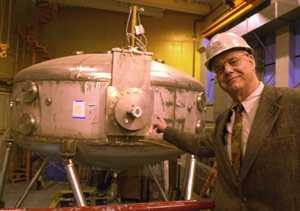Fusion energy, the process that powers the sun, could become part of the nation's energy portfolio in the second half of the 21st century, an MIT professor reported Feb. 17 at the AAAS meeting. His prediction is based on increased federal interest in the field and recent progress in fusion energy research. ������
"With adequate federal funding, a prototype nuclear fusion reactor could be tested within 30 to 40 years, and a commercial reactor could be deployed by the middle of the century," said Miklos Porkolab, director of the Plasma Science and Fusion Center and a professor of physics. His talk was part of a panel discussion titled "Revisiting Nuclear Power for the Energy Crisis."
Recently, the White House and Congress have showed increased interest in fusion and other "next-generation" energy technologies. For example, the president's National Energy Policy Development Group recommended that the president direct the secretary of energy to develop such technologies, and in 2001 Congress authorized a 34 percent increase in the fiscal 2003 budget for the Office of Fusion Energy Sciences. A similar authorization bill is still pending in the Senate.
It remains to be seen whether such large increases would be approved, given the present budget shortfalls in Washington. In the president's budget for 2003, a modest increase was provided to more fully operate the major national fusion research facilities, including MIT's Alcator C-Mod tokamak.
In nuclear fusion, light elements are fused together at enormous pressures to make heavier elements, a process that releases large amounts of energy. For some 50 years, scientists have been studying how to reproduce this process on Earth, because among other advantages, the resulting energy would be clean, with no carbon dioxide emissions. In addition, there is an inexhaustible supply of the fuel itself (heavy forms of hydrogen).
Porkolab said the deployment of a fusion reactor around 2050 "is consistent with the time scale when the domestic supply of crude oil in the US is expected to be depleted, shortages in oil and natural gas could develop in the world markets, and when carbon dioxide reduction in the atmosphere becomes a critical issue."
Recent results
At his AAAS talk, Porkolab gave examples of recent results in the science behind nuclear fusion. "Progress in fusion research over the last decade has been enormous, even with declining US budgets in recent years," he said.
One of the key factors involved in maintaining the high temperatures necessary for nuclear fusion is the control of turbulence. Much like a stick that is driven to the shore in a roaring whitewater river, heat tends to escape too rapidly from the roiling mass of turbulent charged gas, or plasma, in a fusion reactor.
Porkolab said that optimistic predictions in the 1950s and 1960s about near-term commercial fusion proved unfounded because the heat loss from turbulence turned out to be much greater than expected. As a result, "much of fusion research over the last several decades has focused on learning about turbulence and devising techniques to control it."
Over the last few years, scientists at MIT and around the world have made significant strides toward doing just that. Among other things, they have demonstrated ways to break up the "tidal waves" of plasma into smaller eddies that don't carry away heat as rapidly as larger ones. "We have shown that, in principle, it's possible to eliminate turbulence," Porkolab said. "To me, this is just a mind-boggling achievement."
Powerful computers have also proved key to learning more about hot plasmas and the turbulent transport processes. For example, Porkolab said, at an American Physical Society meeting in November 2001, Princeton researchers showed by means of computer simulations that the "deleterious effects of heat loss resulting from turbulence seem to be reduced as one scales up from present-day experiments to future reactor-size machines."
He stressed, however, that "it's dangerous to jump to conclusions based only on simulations. Computer results must be verified with experiments. That's why it's important to expand our present research activity on ongoing experiments, and at the same time move ahead with construction of the next major scale experiment studying the physics of burning plasmas (the burning plasma experiment)."
MIT's Alcator C-Mod is one of only three major research fusion experiments in the United States, the others being DIII-D run by General Atomics in San Diego and the National Spherical Torus Experiment at Princeton. The MIT fusion work is supported by the Department of Energy.
A version of this article appeared in MIT Tech Talk on February 27, 2002.






